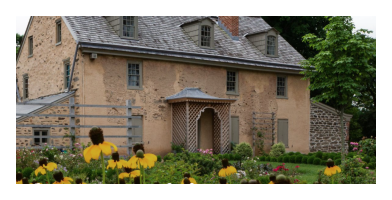Bartram's Garden
5400 Lindbergh Boulevard
Philadelphia, PA 19143
United States
Bartram's Garden- John Bartram House
Bartram's Garden- John Bartram House

Interest in plants came naturally to many of the farmer colonists of North America, and the first systematic botanical garden was this one, created by the self-taught John Bartram (1699-1777), sometimes called the “father of American botany.” Growing up on a farm with his Quaker parents, Bartram’s curiosity led him to explore the countryside and collect plant specimens, and while he read widely and corresponded with the greatest botanical scientists of his time, his chief motivation was an unbridled love of nature.
In 1728 Bartram acquired 112 acres of farmland on the west bank of the Schuylkill. There was an old stone house on the property, and he settled in and used it as his base for the exploratory trips that began locally but soon ranged widely, taking him to Ontario, the Appalachians, Georgia, and Florida. He brought home the specimens he collected, planting them in a garden that stretched from his house toward the river, and which he laid out with a simple grid of paths. Gardening was done by a staff of free, indentured, and enslaved workers.
Bartram also grew his collection by exchanging specimen plants with other botanists in an extraordinary international network. His correspondents included Carl Linnaeus, Johann Jacob Dillenius, and Laurens Theodorus Gronovius—respectively eminent Swedish, Dutch, and German botanists. In 1733 he was introduced to Peter Collinson, a London wool merchant, fellow Quaker, and avid botanist. They corresponded for nearly 35 years, exchanging information and plants. Collinson introduced him to the English scientists John Fothergill, Peter Miller, and Mark Catesby and ultimately orchestrated Bartram’s appointment as botanist to King George III--with an annual stipend of £50.
When Bartram began to improve his home in 1731, he incorporated the narrow earlier building, which was only one room deep. Splitting the local stone, laying it, and carving the ornament himself, he expanded the house in several stages. He added a kitchen around 1740, and between 1758 and 1770 he more than doubled its size, raising the roof and adding a second layer of rooms facing the river. This expansion included an eccentric recessed porch, screened by three columns (rather than the usual even number) with crude Ionic capitals. The window surrounds have energetic, rococo-like ornament.
Bartram also built the seedhouse (1737), stable and carriage shed (1743), and greenhouse (1760), and his son John built the barn (1775).
After Bartram's death, his son William, also a noted botanist, continued to enlarge the famous garden. The collection was reported to contain 129 varieties in the mid nineteenth century. The property was acquired by the Eastwick family and ultimately transferred to the Fairmount Park Commission in 1923.